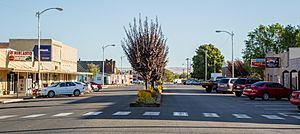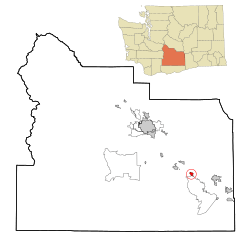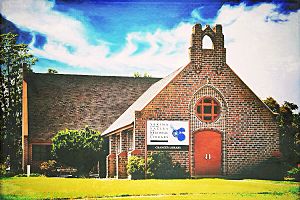Granger, Washington facts for kids
Quick facts for kids
Granger, Washington
|
|
|---|---|

Main Street
|
|
| Motto(s):
Where Dinosaurs Roam
|
|

Location of Granger in Washington
|
|
| Country | United States |
| State | Washington |
| County | Yakima |
| Area | |
| • Total | 1.74 sq mi (4.51 km2) |
| • Land | 1.73 sq mi (4.48 km2) |
| • Water | 0.01 sq mi (0.04 km2) |
| Elevation | 732 ft (223 m) |
| Population
(2020)
|
|
| • Total | 3,624 |
| • Estimate
(2021)
|
3,668 |
| • Density | 2,216.44/sq mi (855.85/km2) |
| Time zone | UTC-8 (PST) |
| • Summer (DST) | UTC-7 (PDT) |
| ZIP code |
98932
|
| Area code | 509 |
| FIPS code | 53-27960 |
| GNIS feature ID | 1505218 |
Granger is a city in Yakima County, Washington, United States. The population was 3,624 at the 2020 census. Although it was classified as a town in 2000, it has since been reclassified as a city.
History
Granger was founded in 1902 and named after Walter Granger, superintendent of the Washington Irrigation Company who also laid out the cities of Zillah and Sunnyside. Granger was officially incorporated on September 28, 1909. In the 1910s and 1920s, the town had several large industries including a tile and brick company and a cider mill.
The Granger Farm Workers Camp, which opened in May 1941 two miles north of the city, became known as the Crewport, Washington Farm Labor Camp. It was built by the Farm Security Administration to house Dust Bowl refugees, initially White, and later Mexican Americans, who were brought in to work in the Yakima Valley as a result of World War II labor shortages. The camp closed in the late 1960s.
Geography
Granger is located at 46°20′40″N 120°11′29″W / 46.34444°N 120.19139°W (46.344319, -120.191290).
According to the United States Census Bureau, the city has a total area of 1.80 square miles (4.66 km2), of which, 1.79 square miles (4.64 km2) is land and 0.01 square miles (0.03 km2) is water.
Demographics
| Historical population | |||
|---|---|---|---|
| Census | Pop. | %± | |
| 1910 | 453 | — | |
| 1920 | 412 | −9.1% | |
| 1930 | 568 | 37.9% | |
| 1940 | 752 | 32.4% | |
| 1950 | 1,164 | 54.8% | |
| 1960 | 1,424 | 22.3% | |
| 1970 | 1,567 | 10.0% | |
| 1980 | 1,812 | 15.6% | |
| 1990 | 2,053 | 13.3% | |
| 2000 | 2,530 | 23.2% | |
| 2010 | 3,246 | 28.3% | |
| 2020 | 3,624 | 11.6% | |
| 2021 (est.) | 3,668 | 13.0% | |
| U.S. Decennial Census 2020 Census |
|||
2010 census
As of the 2010 census, there were 3,246 people, 774 households, and 675 families living in the city. The population density was 1,813.4 inhabitants per square mile (700.2/km2). There were 813 housing units at an average density of 454.2 per square mile (175.4/km2). The racial makeup of the city was 48.6% White, 0.4% African American, 1.7% Native American, 0.5% Asian, 46.9% from other races, and 1.9% from two or more races. Hispanic or Latino of any race were 88.2% of the population.
There were 774 households, of which 66.3% had children under the age of 18 living with them, 60.2% were married couples living together, 17.6% had a female householder with no husband present, 9.4% had a male householder with no wife present, and 12.8% were non-families. 10.5% of all households were made up of individuals, and 4.5% had someone living alone who was 65 years of age or older. The average household size was 4.14 and the average family size was 4.41.
The median age in the city was 22.2 years. 43% of residents were under the age of 18; 11% were between the ages of 18 and 24; 26.4% were from 25 to 44; 14.9% were from 45 to 64; and 4.8% were 65 years of age or older. The gender makeup of the city was 50.5% male and 49.5% female.
Art
There are 32 life-size dinosaur models on display around the town of Granger. They are constructed from a skeleton of steel rods and chicken wire which is then packed with a cement mix. The idea of using a dinosaur exhibit to attract tourists was first proposed in 1993 and the first dinosaur—a juvenile brontosaurus in Hisey Park—was installed in 1994.
Media
Granger is home to a branch of the Yakima Valley Libraries system that is located in a former Catholic church. The city's museum shared the same building until a new facility was opened in 2024.
The Latin radio station "Radio Cadena" or "Radio KDNA" building is in the town of Granger, and was first built in 1979. It was an activist radio station that educated farm workers, advocated farm workers' organizations, and provided Spanish language programs to non-English speaking families. In 2008, a new station building was built.
Notable people
- Fred Oldfield, a cowboy and noted artist, is originally from Alfalfa, a subdivision of Granger.
See also
 In Spanish: Granger (Washington) para niños
In Spanish: Granger (Washington) para niños


